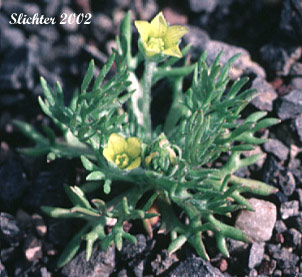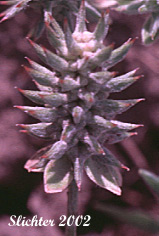

 The
photo at right shows a close-up of the stickery fruit of hornseed buttercup, photographed
south of Condon, OR...........April 30, 2000. Note the persistent, broad, greenish
sepals flared downward from the spiny achenes.
The
photo at right shows a close-up of the stickery fruit of hornseed buttercup, photographed
south of Condon, OR...........April 30, 2000. Note the persistent, broad, greenish
sepals flared downward from the spiny achenes.
Hornseed buttercup is a weedy species which has spread rapidly via the very sharp, stickery seeds which lodge in shoes, clothes and on animal fur. It is an annual weed with one to several leafless stems arising 2-8 cm from a cluster of basal leaves. The leaves are 1.5-4 cm long, ternately divided at the tips to resemble a crows foot, which is one of its common names. The herbage consists of many white or grayish, woolly hairs covering the stems and fruits.
The sepals are greenish, 4-6 mm long with an ovate-lanceolate shape. The sepals persist after flowering. The 5 petals are yellow or white with pink veins after drying, narrowly oblanceolate in shape and about 5-8 mm long The stamens number 10-15. The fruit consists of from 35-70 achenes arranged in a cylindrical cluster to 15 mm long. Individual achenes are thicker at one end with two blister-like bulges while the other end consists of a laterally compressed beak with a very sharp tip, from 3-4 mm long (See photo at right.)
Hornseed buttercup is a weedy species of disturbed places such as overgrazed lands, campgrounds, and areas heavily impacted by off road driving.
Originally an Eurasian species, hornseed buttercup has spread rapidly throughout the northwestern United States to the east of the Cascade Mts. It is currently found in eastern Washington, eastern Oregon, Idaho, Nevada and Colorado.
In the Columbia River Gorge it may be found between the elevations of 100'-2800' from the Klickitat River east towards Biggs Junction.